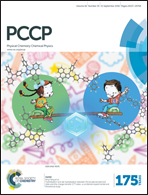Photocycloaddition reaction of atropisomeric maleimides: mechanism and selectivity†
Abstract
We report a density functional study on the mechanism of the [2+2] photocyclization of atropisomeric maleimides. Experimentally, the reaction is known to proceed through the triplet state. We have located all relevant S0 and T1 minima and transition states, as well as the T1/S0 crossing points, and mapped eight stepwise photocyclization pathways for four different conformers in the T1 state that lead to distinct regioisomers. In the preferred four pathways (one for each conformer) the initially formed C–C bond involves the terminal carbon atom of the alkene moiety. This regioselectivity originates from electrostatic preferences (arising from the charge distribution in the polarized C![[double bond, length as m-dash]](https://www.rsc.org/images/entities/char_e001.gif) C double bonds) and from the different thermodynamic stability of the resulting triplet diradical intermediates (caused by electron donation effects that stabilize the radical centers). The formation of the second C–C bond is blocked in the T1 state by prohibitively high barriers and thus occurs after intersystem crossing to the ground state. Furthermore, we rationalize substitution effects on enantioselectivity and diastereoselectivity and identify their origin.
C double bonds) and from the different thermodynamic stability of the resulting triplet diradical intermediates (caused by electron donation effects that stabilize the radical centers). The formation of the second C–C bond is blocked in the T1 state by prohibitively high barriers and thus occurs after intersystem crossing to the ground state. Furthermore, we rationalize substitution effects on enantioselectivity and diastereoselectivity and identify their origin.


 Please wait while we load your content...
Please wait while we load your content...